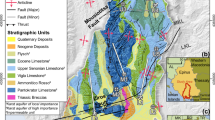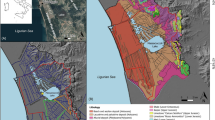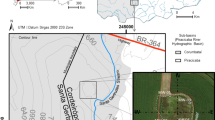Abstract
Calcareous fens are peat-accumulating wetlands fed by calcium-rich groundwater that support several threatened species of plants that thrive in these geochemical conditions. This investigation characterized the hydrology of two calcareous fens in the Glacial Lake Agassiz beach ridge complex in northwestern Minnesota, USA. Sandy surficial beach ridge aquifers and underlying buried glacial aquifers were considered as sources of groundwater to the fen. A combination of the two sources influenced by seasonal hydrology was also considered. Synchronous hydrologic responses to rainfall events and hydraulic gradients indicate the calcareous fens are well-connected to the beach-ridge aquifers. Chemistry of water discharging to the fens is calcium-magnesium-bicarbonate type similar to the beach ridge aquifers, and distinct from buried aquifers that have significant sodium and chloride. High tritium values and oxygen isotope signatures similar to the beach ridge aquifers characterized fen water. Beach ridge aquifer complexes are relatively thin (8–10 m) and overlie thick clay/clay loam till. These beach ridges exhibit high seasonal recharge and have permanent saturated zones, providing a continual source of calcium-rich water for the fens. Electrical resistivity profiles characterized the glacial stratigraphy and highlighted the well-developed physical connection between beach ridge aquifers and calcareous fens. The results of this study allow evaluation of the potential impacts of irrigation and aggregate quarrying on calcareous fens along sand and gravel beach ridges.









Similar content being viewed by others
Data Availability
All data collected during this investigation including hydrology, water chemistry, and geophysics are included in the manuscript and accompanying supporting information.
Code Availability
Not applicable.
References
U.S. Fish and Wildlife Service (2019) GIS Dataset: National Wetlands Inventory. https://fws.gov/wetlands/Data/Data-Download.html
Aaseng N, Almendinger J, Dana R, Klein TR, Lee M, Rowe E, Whitfeld T, Wovcha D (2005) Field Guide to the Native Plant Communities of Minnesota: The Prairie Parkland and Tallgrass Aspen Parklands Provinces. Ecological Land Classification Program, Minnesota County Biological Survey and Natural Heritage and Nongame Research Program, Minnesota Department of Natural Resources, St Paul, Minnesota
Alexander SC, Alexander EC Jr (2015) Field and Laboratory Methods, Hydrogeochemistry Laboratory. University of Minnesota, Minneapolis, Minnesota, Department of Earth Sciences
Almendinger JE, Leete JH, (1998a) Peat Characteristics and Groundwater Geochemistry of Calcareous Fens in the Minnesota River Basin, USA. Biogeochemistry 43:17–41. https://www.jstor.org/stable/1469487
Almendinger JE, Leete JH (1998b) Regional and Local Hydrogeology of Calcareous Fens in the Minnesota River Basin, USA. Wetlands 18:184–202. https://doi.org/10.1007/BF03161655
Amon JP, Thompson CA, Carpenter QJ, Miner J (2002) Temperate zone fens of the glaciated Midwestern USA. Wetlands 22:301–317. https://springer.longhoe.net/article/https://doi.org/10.1672/0277-5212(2002)022[0301:TZFOTG]2.0.CO;2
Bedford BL, Godwin KS (2003) Fens of the United States: Distribution, Characteristics, and Scientific Connection versus Legal Isolation. Wetlands 23:608–629. https://doi.org/10.1672/0277-5212(2003)023[0608:FOTUSD]2.0.CO;2
Bowles ML, Kelsey PD, McBride JL (2005) Relationships among environmental factors, vegetation zones, and species richness in a North American calcareous prairie fen. Wetlands 25:685–696. https://doi.org/10.1672/0277-5212(2005)025[0685:RAEFVZ]2.0.CO;2
Boyer MLH, Wheeler BD (1989) Vegetation Patterns in Spring-Fed Calcareous Fens: Calcite Precipitation and Constraints on Fertility. Journal of Ecohydrology 77:597–609. https://doi.org/10.2307/2260772
Braun Intertec (2014) Memo: Data and Analysis of the Pum** test for Keith Chisholm Farms, Gary Minneosta, presented to Minnesota DNR. Project BL-13–02357.
Clark I (2015) Groundwater Geochemistry and Isotopes. CRC Press, Boca Raton, FL
Community Collaborative Rain, Hail, and Snow Network (2019). https://cocorahs.org
Hach Company (2018) Method 8203: Phenolphthalein and Total Alkalinity. DOC316.53.01166
Cowdery TK, Lorenz DL, Arntson AD (2008) Hydrology prior to wetland and prairie restoration in and around the Glacial Ridge National Wildlife Refuge, northwestern Minnesota, 2002–5. U.S. Geological Survey Scientific Investigations Report 2007–5200.
Cowdery TK, Christenson CA, Ziegeweid JR (2019) The Hydrologic Benefits of Wetland and Prairie Restoration in Western Minnesota—Lessons Learned at the Glacial Ridge National Wildlife Refuge, 2002–15. U.S. Geological Survey Scientific Investigations Report 2019–5041.
Duval TP, Waddington JM (2018) Effect of hydrogeomorphic setting on calcareous fen hydrology. Hydrological Processes 32:1695–1708. https://doi.org/10.1002/hyp.11625
Duval TP, Waddington JM, Branfireun BA (2012) Hydrological and biogeochemical controls on plant species distribution within calcareous fens. Ecohydrology 5:73–89. https://doi.org/10.1002/eco.202
Eggers SD, Reed DM (2011) Wetland Plants and Plant Communities of Minnesota and Wisconsin, Third Edition. U.S. Army Corps of Engineers, St. Paul District
Harris KL (1995) Quaternary Geology-Southern Red River Valley, Minnesota [Part A]. Minnesota Geological Survey, Minneapolis, Minnesota. https://hdl.handle.net/11299/59764
Jiménez-Martínez J, Longuevergn L, Le Borgne T, Davy P, Russian A, Bour O (2013) Temporal and spatial scaling of hydraulic response to recharge in fractured aquifers: insights from a frequency domain analysis. Water Resour Res 49:3007–3023. https://doi.org/10.1002/wrcr.20260
Knudby C, Carrera J (2006) On the use of apparent hydraulic diffusivity as an indicator of connectivity. J Hydrol 329:377–389. https://doi.org/10.1016/j.jhydrol.2006.02.026
Komor SC (1994) Geochemistry and hydrology of a calcareous fen within the Savage Fen wetlands complex, Minnesota, USA. Geochemica et Cosmochimica Acta 58:3353–3367. https://linkinghub.elsevier.com/retrieve/pii/0016703794900914
Leete JH, Smith WR, Janssens JA, Aaseng N (2005) Final Report to the US EPA: Test of the Technical Criteria for Identifying and Delineating Calcareous Fens in Minnesota. Minnesota Department of Natural Resources, St. Paul, Minnesota. http://files.dnr.state.mn.us/eco/wetlands/calfen_criteria_restatement.pdf
Lindgren, RJ (1996) Availability and Quality of Water from Drift Aquifers in Marshall, Pennington, Polk, and Red Lake Counties, Northwestern Minnesota. U.S. Geological Survey Water Resources Investigations Report 95–4201.
Lindsey BD, Jurgens BC, Belitz K (2019) Tritium as an indicator of modern, mixed, and premodern groundwater age. U.S. Geological Survey Scientific Investigations Report 2019–5090.
Matheny RK, Gerla PJ (1996) Environmental isotopic evidence for the origins of ground and surface water in a prairie discharge wetland. Wetlands 16:109–120. https://doi.org/10.1007/BF03160684
McBride MS, Pfannkuch HO (1975) The Distribution of Seepage within Lakebeds. J Res US Geol Surv 3:505–512
Merritt RG, Pavlish JA, Berg JA, Leete JH (2002) Impacts of Sand and Gravel Mining in the Felton Prairie Area on Down Gradient Calcareous Fens. Minnesota Department of Natural Resources, St. Paul, Minnesota. http://files.dnr.state.mn.us/waters/groundwater_section/tech/feltonfen_report2002.pdf
Miner JJ, Ketterling DB (2003) Dynamics of Peat Accumulation and Marl Flat Formation in a Calcareous Fen, Midwestern United States. Wetlands 23:950–960. https://doi.org/10.1672/0277-5212(2003)023[0950:DOPAAM]2.0.CO;2
Minnesota Department of Health (2020) Minnesota Well Index Database, https://mnwellindex.web.health.state.mn.us/.
Minnesota Department of Natural Resources (2016) Technical Criteria for Identifying Calcareous Fens in Minnesota. https://files.dnr.state.mn.us/natural_resources/water/wetlands/calcareous-fen-identifying.pdf
Minnesota Department of Natural Resources (2018) Calcareous Fen Field Assessment Procedures. https://files.dnr.state.mn.us/natural_resources/water/wetlands/calcareous-fen-field-assessment.pdf
Minnesota Department of Natural Resources (2019) GIS dataset: Native Plant Communities. https://gisdata.mn.gov/dataset/biota-dnr-native-plant-comm
Minnesota Department of Natural Resources (2020) Cooperative Groundwater Monitoring Database. https://www.dnr.state.mn.us/waters/cgm/index.html
Minnesota Geospatial Commons (2021) Lidar Elevation data for Minnesota. Lidar Information (state.mn.us)
Minnesota Statute 8420.0935 (2018). https://www.revisor.mn.gov/rules/8420.0935/
National Oceanic and Atmospheric Administration National Centers for Environmental Information (NOAA NCEI) (2019) Climate at Glance: City Time Series. https://www.ncdc.noaa.gov/cag/
Pavlish JA, (2004) Impacts of sub water table gravel mining on the ground water feeding a Clay County, Minnesota calcareous fen. MS Thesis, University of Minnesota, Minneapolis, Minnesota.
Pfannkuch HO, Mooers HD, Siegel DI, Quinn JJ, Rosenberry DO, Alexander SC (2021) “Jacob’s Zoo”—how using Jacob’s method for aquifer testing leads to more intuitive understanding of aquifer characteristics. Hydrogeol J 29:2001–2015. https://doi.org/10.1007/s10040-021-02363-7
Remenda VH, Cherry JA, Edwards TWD (1994) Isotopic Composition of Old Ground Water from Lake Agassiz for Late Pleistocene Climate. Science 266:1975–1978. https://doi.org/10.1126/science.266.5193.1975
Shih DCF (2018) Hydraulic diffusivity in a coastal aquifer: spectral analysis of groundwater level in responses to marine system. Stochastic Environmental Research and Risk Assessment 32:311–320. https://doi.org/10.1007/s00477-017-1420-1
Siegel DI (1989) Geochemistry of the Cambrian-Ordovician Aquifer System in the Northern Midwest, United States. U.S. Geological Survey Professional Paper 1405-D
Solinst (2020) Levelogger Model 3001 Data Sheet
Summit Envirosolutions, Inc. (2015) Aquifer Test Report for Chisholm Farms, Gary, Minnesota. Project 2227–0001
Teller JT (1987) Proglacial lakes and the southern margin of the Laurentide Ice Sheet, in Ruddiman WF and Wright HE Jr. [eds.] North America and adjacent oceans during the last deglaciation. Geological Society of America: The Geology of North America, K3:39–70.
Theis CV (1935) The relation between the lowering of the piezometric surface and the rate and duration of discharge of a well using ground-water storage. EOS Trans Am Geophys Union 16:519–524. https://doi.org/10.1029/TR016i002p00519
Thompson CA, Bettis EA, Baker RG (1992) Geology of Iowa Fens. Journal of the Iowa Academy of Science 99:53–59. https://scholarworks.uni.edu/jias/vol99/iss2/4
Thorleifson LH (1996) Review of Lake Agassiz history. In: Teller JT, Thorleifson LH, Matile G. and Brisbin WC (eds) Sedimentology, Geomorphology, and History of the Central Lake Agassiz Basin. Geological Association of Canada Field Trip Guidebook B2, pp 55–84
U.S. Department of Agriculture (2017) National Agriculture Imagery Program (NAIP). https://www.mngeo.state.mn.us/chouse/wms/geo_image_server.html
U.S. Geological Survey (2004) Minnesota Digital Elevation Model - 30 Meter Resolution. https://gisdata.mn.gov/dataset/elev-30m-digital-elevation-model
Acknowledgements
This research was funded by the Graduate School of the University of Minnesota and by the Geology Research Fund in the Department of Earth and Environmental Sciences at the University of Minnesota Duluth. The authors would like to thank Jason Ver Steeg of Duininck Companies, Keith Chisholm, and other landowners for access to their properties for the research project. Various departments and individuals at the University of Minnesota helped provide equipment and expertise as well as laboratory services that made this project possible. This includes the co-authors, Salli Dymond, John Pastor, Nate Johnson, Julie Agnich, the College of Food, Agricultural, and Natural Resource Science’s Research Analytical Lab, and the Natural Resources Research Institute. The U.S. Geological Survey lent the pressure transducers used for this project. The Tritium Laboratory at the University of Miami donated the tritium analyses used in this project through the Geological Society of America. Any use of trade, firm, or product names is for descriptive purposes only and does not imply endorsement by the University of Minnesota or the United States Government.
Funding
This project was supported with funds from the University of Minnesota Graduate School and the Geology Research Fund in the Department of Earth and Environmental Sciences, University of Minnesota Duluth.
Author information
Authors and Affiliations
Contributions
Nicholas Budde, Howard Mooers, and Timothy Cowdery contributed to the study conception and design. Installation of monitoring wells and recording equipment was conducted by Nicholas Budde and Howard Mooers, data collection and analysis were performed primarily by Nicholas Budde with help from Howard Mooers and a field assistant. Timothy Cowdery advised on methodology throughout the project. Nigel Wattrus provided geophysical equipment, advised on geophysical survey design, and processed geophysical data. The first draft of the manuscript was written by Nicholas Budde, and all authors commented on previous versions of the manuscript. All authors read and approved the final manuscript.
Corresponding author
Ethics declarations
Conflicts of Interest
Not applicable.
Ethics Approval
Not applicable.
Consent to Participate
Not applicable.
Consent for Publication
Not applicable.
Additional information
Publisher’s Note
Springer Nature remains neutral with regard to jurisdictional claims in published maps and institutional affiliations.
Supplementary Information
Below is the link to the electronic supplementary material.
Rights and permissions
About this article
Cite this article
Budde, N.R., Mooers, H.D., Cowdery, T.K. et al. Long-Term Hydrologic Sustainability of Calcareous Fens along the Glacial Lake Agassiz Beach Ridges, Northwestern Minnesota, USA. Wetlands 42, 28 (2022). https://doi.org/10.1007/s13157-022-01544-8
Received:
Accepted:
Published:
DOI: https://doi.org/10.1007/s13157-022-01544-8




